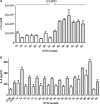Characterization of nontypable Haemophilus influenzae isolates recovered from adult patients with underlying chronic lung disease reveals genotypic and phenotypic traits associated with persistent infection
- PMID: 24824990
- PMCID: PMC4019658
- DOI: 10.1371/journal.pone.0097020
Characterization of nontypable Haemophilus influenzae isolates recovered from adult patients with underlying chronic lung disease reveals genotypic and phenotypic traits associated with persistent infection
Erratum in
- PLoS One. 2014;9(9):e107686
Abstract
Nontypable Haemophilus influenzae (NTHi) has emerged as an important opportunistic pathogen causing infection in adults suffering obstructive lung diseases. Existing evidence associates chronic infection by NTHi to the progression of the chronic respiratory disease, but specific features of NTHi associated with persistence have not been comprehensively addressed. To provide clues about adaptive strategies adopted by NTHi during persistent infection, we compared sequential persistent isolates with newly acquired isolates in sputa from six patients with chronic obstructive lung disease. Pulse field gel electrophoresis (PFGE) identified three patients with consecutive persistent strains and three with new strains. Phenotypic characterisation included infection of respiratory epithelial cells, bacterial self-aggregation, biofilm formation and resistance to antimicrobial peptides (AMP). Persistent isolates differed from new strains in showing low epithelial adhesion and inability to form biofilms when grown under continuous-flow culture conditions in microfermenters. Self-aggregation clustered the strains by patient, not by persistence. Increasing resistance to AMPs was observed for each series of persistent isolates; this was not associated with lipooligosaccharide decoration with phosphorylcholine or with lipid A acylation. Variation was further analyzed for the series of three persistent isolates recovered from patient 1. These isolates displayed comparable growth rate, natural transformation frequency and murine pulmonary infection. Genome sequencing of these three isolates revealed sequential acquisition of single-nucleotide variants in the AMP permease sapC, the heme acquisition systems hgpB, hgpC, hup and hxuC, the 3-deoxy-D-manno-octulosonic acid kinase kdkA, the long-chain fatty acid transporter ompP1, and the phosphoribosylamine glycine ligase purD. Collectively, we frame a range of pathogenic traits and a repertoire of genetic variants in the context of persistent infection by NTHi.
Conflict of interest statement
Figures


References
-
- Sethi S, Mallia P, Johnston SL (2009) New paradigms in the pathogenesis of chronic obstructive pulmonary disease II. Proc Am Thorac Soc 6: 532–534. - PubMed
-
- Sethi S (2010) Infection as a comorbidity of COPD. Eur Respir J 35: 1209–1215. - PubMed
-
- Parameswaran GI, Sethi S (2012) Pseudomonas infection in chronic obstructive pulmonary disease. Future Microbiol 7: 1129–1132. - PubMed
-
- Garmendia J, Morey P, Bengoechea JA (2012) Impact of cigarette smoke exposure on host-bacterial pathogen interactions. Eur Respir J 39: 467–477. - PubMed
Publication types
MeSH terms
Substances
Grants and funding
LinkOut - more resources
Full Text Sources
Other Literature Sources
Medical

